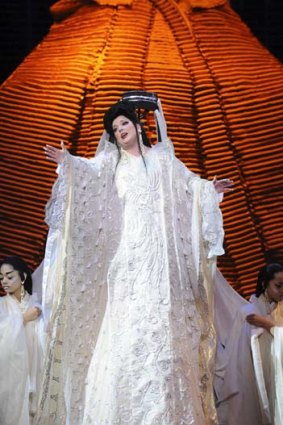By Reviewed by Peter McCallum
TURANDOT
Opera Australia
Opera House, January 17
AFTER more than 20 years, the most striking feature of Graeme Murphy's 1990 production of Puccini's final (and incomplete) opera remains its sense of flow.

Susan Foster.Credit: Branco Gaica
Murphy has taken the first act of Turandot, where Puccini's mature command of musico-dramatic pace sees the intimate and the spectacular merge seamlessly in rapid succession, and created a theatrical shape that seems always in movement. It swirls and flows in gorgeous colour and stark monochrome, and points of emotional intensity expand and retreat like the opening and closing of a great fan.
Indeed the fan - as graceful pattern, as curtain, as veil and as something that both presents itself invitingly then closes sharply into a compact shell - is a recurring motive visually and metaphorically. Crowds open out, undulate and withdraw, while gestures ripple across a group like an expanding circle of fate. As a dancer Murphy has enlisted shape, movement and pattern into the narrative arsenal of opera with a success few have matched, and with telling and delightful effect.
Reverting to a favourite dramatic structure of Verdi's, Puccini shapes much of the musical drama around the massive chorus in the early stages, adding to this a rich sound palette of orchestration, tinged with the acerbity and sparseness of early 20th-century modernism.
The Opera Australia chorus thundered and caressed with impressive power and incisiveness, supplemented by a children's chorus of unforced sweetness. Conductor Arvo Volmer drew piquantly coloured highlights from the orchestra while maintaining a sense of momentum.
As Turandot, Susan Foster was most impressive in the final act, marshalling titanic power in the final duet. In the riddle scene of Act 2, her sound was incisive but stark with plush vibrato.
Rosario La Spina, as Calaf, has never lacked power but tempered it here commendably, cultivating melodic shape in Nessun dorma and nurturing tonal quality.
As Liu, the good true slave girl, Daria Masiero also had a highly active vibrato in the first act, yet captured poignant colour in her tragic final scene of Act 3. Jud Arthur, singing her blind, dependent master, Timur, had a strong, well-centred voice, bringing important vocal weight to the ensembles. As Ping, Pong and Pang, Andrew Moran, David Corcoran and Graeme Macfarlane carried the slightly over-extended scene Puccini wrote for them at the beginning of Act 3 brilliantly (aided by Murphy's inventive play with Chinese screens).
Among the supporting roles, Warwick Fyfe was particularly strong as the Mandarin. Warren Fisher brought surprising lightness to Murphy's mountainously huge Emperor and Jin Tea Kim was serene as the ill-fated Prince of Persia.
There are many reasons to find Puccini's colonial, patronising and often misogynistic orientalism uncomfortable these days, yet this production places all this at the distance of myth and old fable, creating shapes that haunt the memory with precious and beautiful transience.